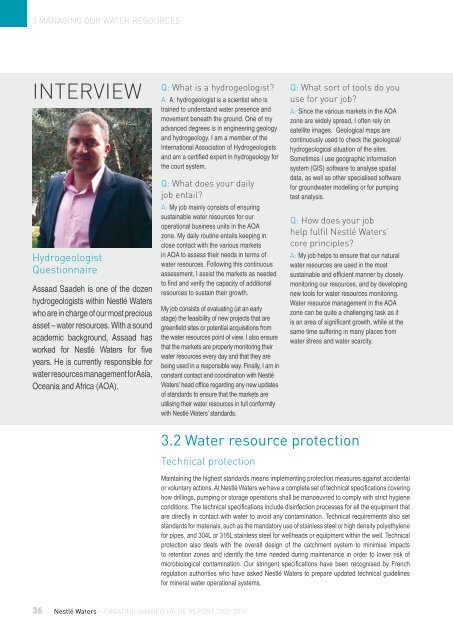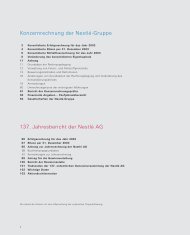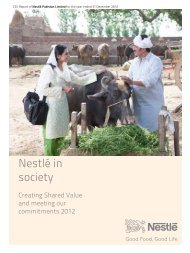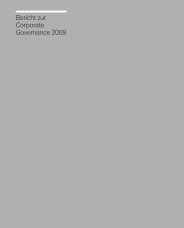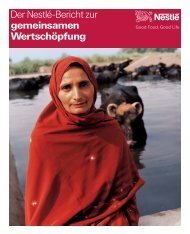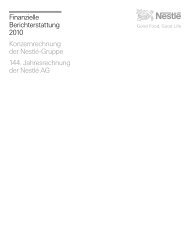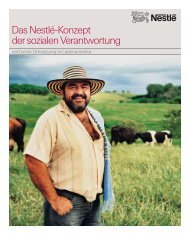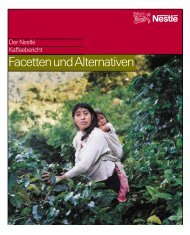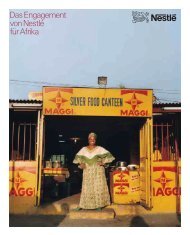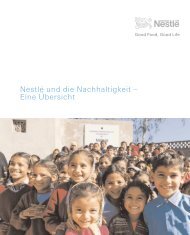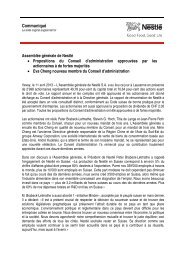Nestlé Waters – Creating Shared Value report
Nestlé Waters – Creating Shared Value report
Nestlé Waters – Creating Shared Value report
You also want an ePaper? Increase the reach of your titles
YUMPU automatically turns print PDFs into web optimized ePapers that Google loves.
3 Managing our water resources<br />
interView<br />
hydrogeologist<br />
Questionnaire<br />
Assaad Saadeh is one of the dozen<br />
hydrogeologists within <strong>Nestlé</strong> <strong>Waters</strong><br />
who are in charge of our most precious<br />
asset <strong>–</strong> water resources. With a sound<br />
academic background, Assaad has<br />
worked for <strong>Nestlé</strong> <strong>Waters</strong> for five<br />
years. He is currently responsible for<br />
water resources management for Asia,<br />
Oceania and Africa (AOA).<br />
36<br />
Q: what is a hydrogeologist?<br />
a: A: hydrogeologist is a scientist who is<br />
trained to understand water presence and<br />
movement beneath the ground. One of my<br />
advanced degrees is in engineering geology<br />
and hydrogeology. I am a member of the<br />
International Association of Hydrogeologists<br />
and am a certified expert in hydrogeology for<br />
the court system.<br />
Q: what does your daily<br />
job entail?<br />
a: My job mainly consists of ensuring<br />
sustainable water resources for our<br />
operational business units in the AOA<br />
zone. My daily routine entails keeping in<br />
close contact with the various markets<br />
in AOA to assess their needs in terms of<br />
water resources. Following this continuous<br />
assessment, I assist the markets as needed<br />
to find and verify the capacity of additional<br />
resources to sustain their growth.<br />
My job consists of evaluating (at an early<br />
stage) the feasibility of new projects that are<br />
greenfield sites or potential acquisitions from<br />
the water resources point of view. I also ensure<br />
that the markets are properly monitoring their<br />
water resources every day and that they are<br />
being used in a responsible way. Finally, I am in<br />
constant contact and coordination with <strong>Nestlé</strong><br />
<strong>Waters</strong>’ head office regarding any new updates<br />
of standards to ensure that the markets are<br />
utilising their water resources in full conformity<br />
with <strong>Nestlé</strong> <strong>Waters</strong>’ standards.<br />
<strong>Nestlé</strong> <strong>Waters</strong> <strong>–</strong> creating shared <strong>Value</strong> <strong>report</strong> 2005-2010<br />
Q: what sort of tools do you<br />
use for your job?<br />
a: Since the various markets in the AOA<br />
zone are widely spread, I often rely on<br />
satellite images. Geological maps are<br />
continuously used to check the geological/<br />
hydrogeological situation of the sites.<br />
Sometimes I use geographic information<br />
system (GIS) software to analyse spatial<br />
data, as well as other specialised software<br />
for groundwater modelling or for pumping<br />
test analysis.<br />
Q: how does your job<br />
help fulfil nestlé waters’<br />
core principles?<br />
a: My job helps to ensure that our natural<br />
water resources are used in the most<br />
sustainable and efficient manner by closely<br />
monitoring our resources, and by developing<br />
new tools for water resources monitoring.<br />
Water resource management in the AOA<br />
zone can be quite a challenging task as it<br />
is an area of significant growth, while at the<br />
same time suffering in many places from<br />
water stress and water scarcity.<br />
3.2 Water resource protection<br />
technical protection<br />
Maintaining the highest standards means implementing protection measures against accidental<br />
or voluntary actions. At <strong>Nestlé</strong> <strong>Waters</strong> we have a complete set of technical specifications covering<br />
how drillings, pumping or storage operations shall be manoeuvred to comply with strict hygiene<br />
conditions. The technical specifications include disinfection processes for all the equipment that<br />
are directly in contact with water to avoid any contamination. Technical requirements also set<br />
standards for materials, such as the mandatory use of stainless steel or high density polyethylene<br />
for pipes, and 304L or 316L stainless steel for wellheads or equipment within the well. Technical<br />
protection also deals with the overall design of the catchment system to minimise impacts<br />
to retention zones and identify the time needed during maintenance in order to lower risk of<br />
microbiological contamination. Our stringent specifications have been recognised by French<br />
regulation authorities who have asked <strong>Nestlé</strong> <strong>Waters</strong> to prepare updated technical guidelines<br />
for mineral water operational systems.


